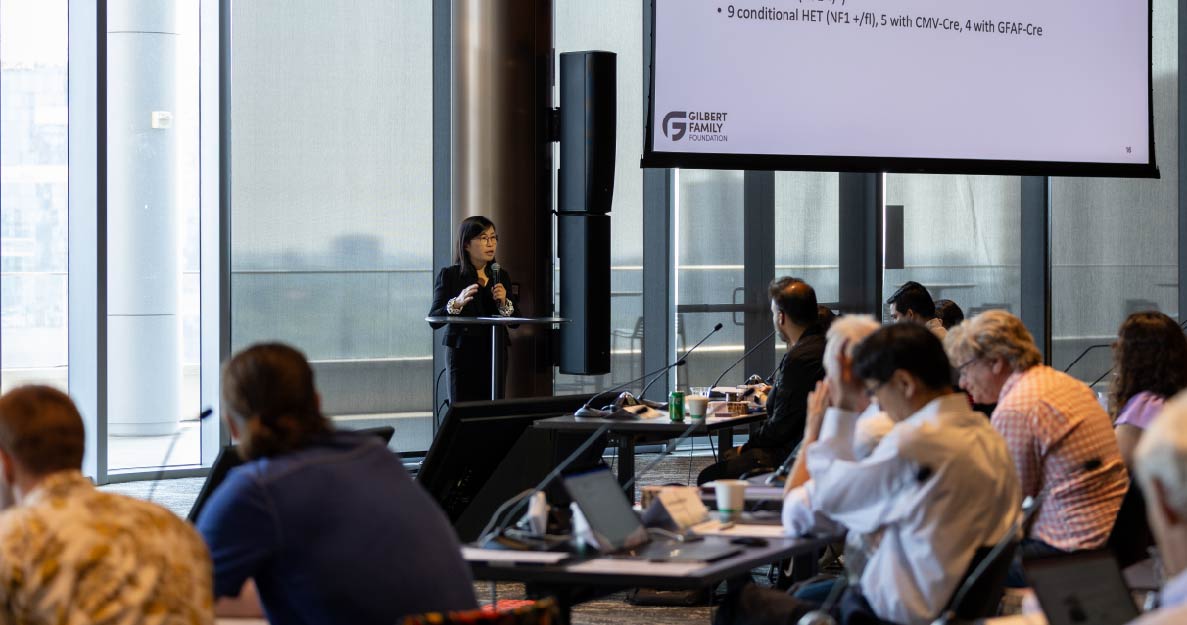Vision Restoration Initiative Annual Meeting Highlights Exciting Milestones
Curing NFVision RestorationAug 15, 2023

Recently our Curing NF team hosted their Vision Restoration Initiative (VRI) Annual Meeting, which brings together their “dream team” of experts from a variety of disciplines to convene on vision restoration therapies for NF1 patients.
Over the course of the two-day event, the teams discuss their progress updates, any challenges they’ve encountered, and their evolving strategies for solidifying this important work.
This year, 14 VRI investigators highlighted their findings in the areas of neuroprotection and cell replacement therapies. Notably, there was a sizeable amount of exciting and important data in NF1-OPG preclinical models which were presented and discussed the first day. This was a key milestone for the current phase of VRI for generating proof-of-concept for vision restoration in these preclinical animal models of NF1-OPG.
On the second day of the meeting, the team conducted a workshop on standardizing our preclinical approach across the consortium. We also invited industry expert and consultant Dr. Kirk Trisler to give a presentation on the elements of an investigational new drug application (IND), which will be necessary for conducting first-in-human trials of new therapies developed by the VRI. Our VRI investigators also had the opportunity to connect with our scientific advisory board members to obtain their feedback on their current research progress and future directions.
“Overall, it was perhaps our most exciting annual meeting to date, as our teams had many new scientific milestones to report,” said Kalyan Vinnakota, Senior Scientific Program Manager who leads the Vision Restoration Initiative. “We are looking forward to many more novel breakthroughs as we continue accelerating a cure for NF.”
Read on to learn more about our Vision Restoration Initiative and why it’s so important to our curing NF work.
More About VRI and Combating Optic Pathway Gliomas
NF1-associated Optic Pathway Gliomas (OPGs) are slow-growing, benign brain tumors that develop around the optic nerves that connect the eyes to the brain. OPGs can cause irreversible vision loss to varying degrees, including complete blindness. The mission of the Gilbert Family Foundation’s Vision Restoration Initiative (VRI) is to develop viable therapies that will ultimately protect and restore vision in NF1-OPG patients.
How Are We Tackling This Complex Problem?
When we created our Vision Restoration Initiative in 2019, there were no vision restoration therapies for patients suffering from vision loss due to OPGs caused by NF1. To date, we have 17 active projects led by 13 “Dream Team” experts in nine institutions. To best address the challenges of vision restoration, we’ve segmented our approach to target patients with varying degrees of vision loss associated with OPGs. We’re developing neuroprotection and neuroenhancement therapies for mild to moderate vision loss, and cell replacement therapies for patients with severe vision loss. Both approaches are being created and tested in various preclinical models along with the identification of biomarkers in patients. This is done in order to determine the most effective type of therapy for each patient.
The efforts of the projects lead by our “Dream Team” which have resulted in significant research output, and we’re excited to see what new breakthroughs our team will bring to fruition as their research progresses.
For more information about our approach and our “Dream Team,” visit our VRI page.